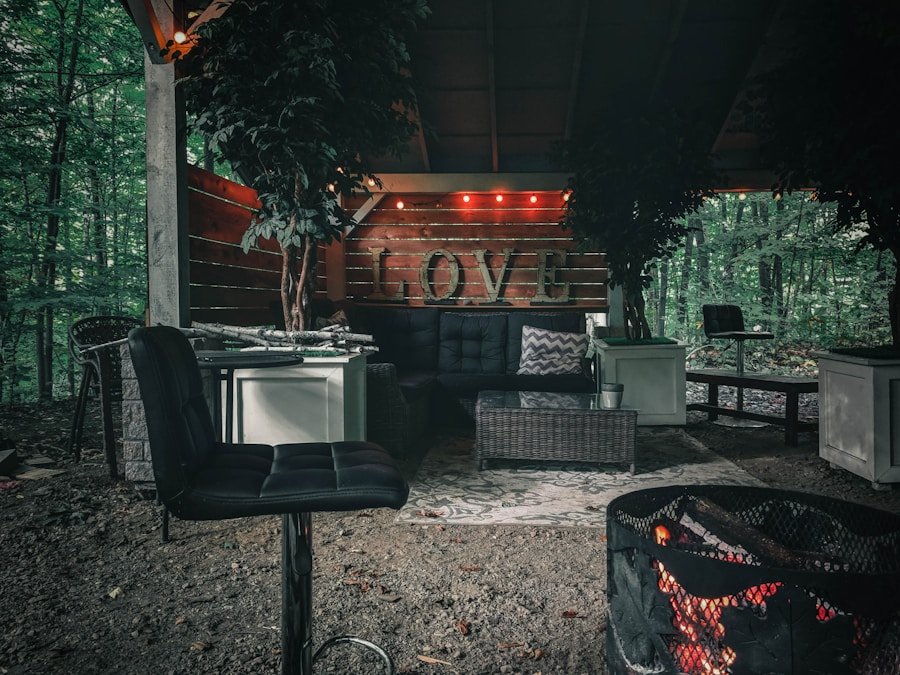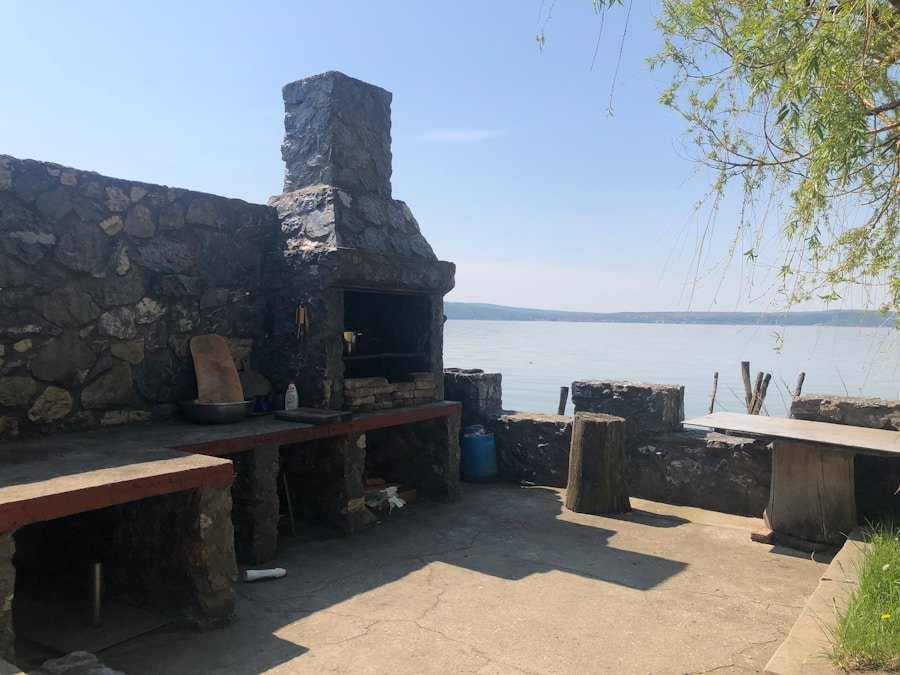When embarking on the journey of creating an outdoor kitchen, the first step is to thoroughly assess your available space and specific needs. This involves not only measuring the physical dimensions of your outdoor area but also considering how you intend to use the kitchen. For instance, if you have a small patio, you may need to prioritize compact appliances and multifunctional furniture.
Conversely, a sprawling backyard could accommodate a more elaborate setup with dedicated zones for cooking, dining, and entertaining. Additionally, understanding your lifestyle is crucial in this assessment phase. Are you an avid entertainer who frequently hosts large gatherings, or do you prefer intimate family meals?
Your cooking habits will dictate the necessary features of your outdoor kitchen. If you often grill or smoke meats, a high-quality grill and smoker should be at the forefront of your design. Alternatively, if you envision preparing full-course meals outdoors, you might require a more comprehensive setup that includes a range, oven, and ample prep space.
By taking the time to evaluate both your space and your culinary needs, you can create a tailored outdoor kitchen that enhances your lifestyle.
Key Takeaways
- Assess your space and needs before designing your outdoor kitchen to ensure it meets your requirements.
- Consider your cooking style to determine the type of appliances and layout that will work best for you.
- Choose the right appliances that are suitable for outdoor use and can withstand various weather conditions.
- Select durable and weather-resistant materials for your outdoor kitchen to ensure longevity and easy maintenance.
- Design a functional layout that allows for efficient cooking and easy movement within the space.
Consider Your Cooking Style
Your cooking style plays a pivotal role in shaping the design and functionality of your outdoor kitchen. For instance, if you are a grilling enthusiast, investing in a premium grill is essential. High-performance gas or charcoal grills can elevate your outdoor cooking experience, allowing you to experiment with various techniques such as searing, smoking, or rotisserie cooking.
Furthermore, consider incorporating additional grilling accessories like side burners or a built-in smoker to expand your culinary repertoire. On the other hand, if you enjoy preparing gourmet meals outdoors, you may want to include a full range of appliances that mimic your indoor kitchen. This could involve installing a built-in oven, a refrigerator for easy access to ingredients, and even a sink for convenient cleanup.
The layout should facilitate a smooth workflow, allowing you to move seamlessly between cooking stations. For example, placing the grill near the prep area and dining space can streamline the process of serving food while keeping guests engaged in conversation. Ultimately, aligning your outdoor kitchen design with your cooking style ensures that it becomes a functional extension of your culinary passions.
Choose the Right Appliances

Selecting the right appliances is a critical component of designing an outdoor kitchen that meets your needs and enhances your cooking experience. The market offers a plethora of options ranging from traditional grills to modern outdoor ovens and even pizza ovens. When choosing appliances, consider their durability and performance in outdoor conditions.
Stainless steel is often the material of choice for outdoor appliances due to its resistance to rust and corrosion, ensuring longevity even in harsh weather. In addition to grills and ovens, think about incorporating other appliances that can elevate your outdoor cooking experience. A built-in refrigerator can keep beverages cold and ingredients fresh without requiring frequent trips indoors.
If you enjoy entertaining, consider adding an outdoor bar with a sink and storage for glassware and utensils. Furthermore, investing in high-quality ventilation systems can help manage smoke and odors, creating a more pleasant environment for both cooks and guests. By carefully selecting appliances that align with your cooking style and outdoor conditions, you can create a kitchen that is both functional and enjoyable.
Select Durable and Weather-Resistant Materials
| Material | Durability Rating | Weather-Resistance Rating |
|---|---|---|
| Stainless Steel | Excellent | Excellent |
| Aluminum | Good | Excellent |
| Teak Wood | Excellent | Good |
| HDPE (High-Density Polyethylene) | Excellent | Excellent |
The materials you choose for your outdoor kitchen are paramount in ensuring its longevity and functionality. Given the exposure to various weather elements—sunlight, rain, wind, and temperature fluctuations—it’s essential to select materials that can withstand these conditions without deteriorating over time. For countertops, options like granite or quartz are popular due to their durability and resistance to staining and scratching.
These materials not only provide a robust work surface but also add an aesthetic appeal that complements the overall design. In addition to countertops, consider the cabinetry and flooring materials as well. Marine-grade polymer cabinets are an excellent choice for outdoor kitchens as they resist moisture and UV damage while providing ample storage space.
For flooring, options such as porcelain tiles or natural stone are ideal due to their ability to endure heavy foot traffic and resist slipping when wet. Incorporating weather-resistant materials throughout your outdoor kitchen will not only enhance its durability but also reduce maintenance efforts over time.
Design a Functional Layout
A well-thought-out layout is essential for maximizing the functionality of your outdoor kitchen. The design should facilitate an efficient workflow while ensuring that all necessary components are easily accessible. One effective approach is to adopt the “kitchen work triangle” concept, which emphasizes the relationship between the grill, prep area, and dining space.
By positioning these elements in close proximity to one another, you can streamline the cooking process and minimize unnecessary movement. Consideration should also be given to traffic flow within the space. Ensure that there is enough room for guests to move around comfortably without disrupting the cooking process.
If you plan to entertain frequently, incorporating an island or bar seating area can create an inviting atmosphere while providing additional prep space. Furthermore, think about incorporating shade structures or pergolas to protect against harsh sunlight or rain, enhancing both comfort and usability throughout the year.
Incorporate Comfortable Seating and Dining Areas

Creating comfortable seating and dining areas is crucial for transforming your outdoor kitchen into a welcoming space for gatherings and meals. The choice of seating should reflect both style and comfort; options range from traditional dining tables with chairs to more casual lounge seating with cushions. If space allows, consider integrating built-in benches or sectional sofas that can accommodate larger groups while providing a cozy atmosphere.
In addition to seating arrangements, think about the dining experience as a whole. A well-designed dining area should be positioned near the cooking zone for easy serving while also offering views of the surrounding landscape or garden. Adding features such as fire pits or outdoor heaters can extend the usability of your dining area into cooler months, making it an inviting space year-round.
By thoughtfully incorporating comfortable seating and dining areas into your outdoor kitchen design, you create an environment that encourages relaxation and social interaction.
Add Stylish and Practical Accessories
Accessories play a significant role in enhancing both the functionality and aesthetic appeal of your outdoor kitchen. From practical tools to decorative elements, these additions can elevate your cooking experience while reflecting your personal style. Start by considering essential accessories such as cutting boards, utensils, and grilling tools that are specifically designed for outdoor use.
Investing in high-quality items will ensure they withstand the rigors of outdoor cooking while providing ease of use. Beyond practicality, stylish accessories can add character to your outdoor kitchen. Consider incorporating decorative elements such as potted herbs for easy access while cooking or colorful dishware that complements your overall design theme.
Outdoor lighting is another crucial accessory; strategically placed fixtures can create ambiance during evening gatherings while ensuring safety around cooking areas. By thoughtfully selecting accessories that blend style with functionality, you can create an outdoor kitchen that is not only efficient but also visually appealing.
Budget and Maintenance Considerations
Establishing a budget is an essential step in planning your outdoor kitchen project. Costs can vary significantly based on factors such as size, materials, appliances, and labor. Begin by outlining your priorities—what features are non-negotiable versus those that can be adjusted based on budget constraints?
Researching different materials and appliances can help you identify options that fit within your financial plan without compromising quality. Maintenance considerations should also be factored into your budget planning. While some materials may have lower upfront costs, they could require more frequent maintenance or replacement over time.
For instance, wood cabinetry may offer aesthetic appeal but could demand regular sealing or refinishing to withstand outdoor conditions. Conversely, investing in durable materials may lead to long-term savings by reducing maintenance efforts and extending the lifespan of your outdoor kitchen components. By carefully balancing budgetary constraints with maintenance considerations, you can create an outdoor kitchen that meets both your financial goals and functional needs.
When choosing an outdoor kitchen for your home, it’s important to consider the durability of the materials used. A related article on the most durable children’s tableware can provide insight into long-lasting options for your outdoor kitchen. Additionally, efficiency is key when selecting appliances for your outdoor space. Check out the most efficient smart power strips for ways to save energy and money. And don’t forget about serving trays for your outdoor gatherings – the best indoor-outdoor serving trays can add style and functionality to your outdoor kitchen setup.
FAQs
What factors should I consider when choosing an outdoor kitchen for my home?
When choosing an outdoor kitchen for your home, consider factors such as the available space, your cooking and entertaining needs, the climate in your area, and your budget.
What are the different types of outdoor kitchens available?
There are various types of outdoor kitchens available, including prefabricated modular units, custom-built kitchens, and portable kitchens. Each type has its own advantages and considerations.
What materials are commonly used for outdoor kitchens?
Common materials used for outdoor kitchens include stainless steel, stone, brick, and concrete. These materials are chosen for their durability and ability to withstand outdoor elements.
What appliances and features should I consider for my outdoor kitchen?
When choosing appliances and features for your outdoor kitchen, consider essentials such as a grill, storage cabinets, countertops, and a sink. Additional features like refrigerators, pizza ovens, and outdoor bars can also enhance your outdoor cooking and entertaining experience.
How can I ensure that my outdoor kitchen is built to last?
To ensure that your outdoor kitchen is built to last, it’s important to use high-quality materials, work with experienced professionals, and properly maintain and care for your outdoor kitchen. Additionally, consider investing in weatherproof covers and protective coatings for your outdoor kitchen appliances and surfaces.

